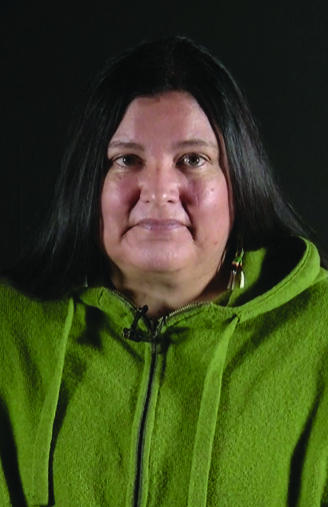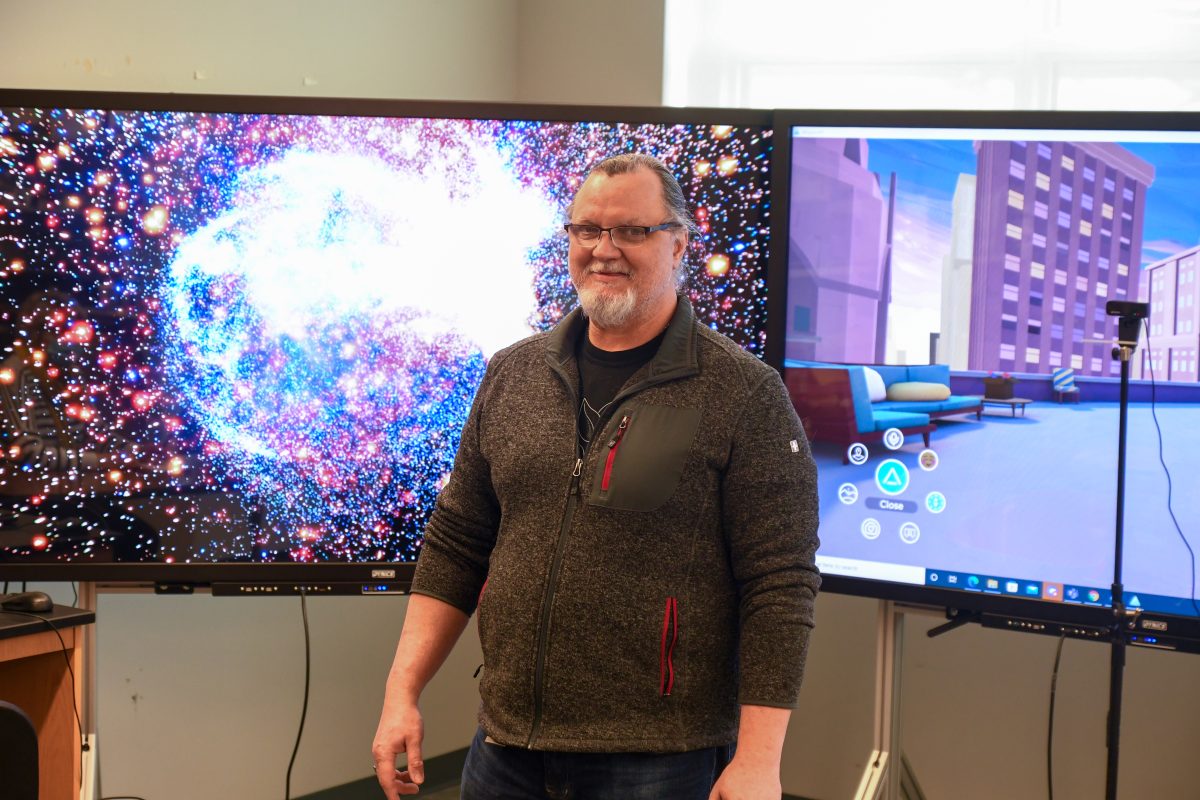When Iyekiyapiwin Darlene St. Clair started her career as an educator, she taught the way she was taught: “That I was to be the expert but not necessarily a skilled teacher.” Through her multiple roles as associate professor of American Indian Studies, director of the Multicultural Resources Center and as a public scholar working with external communities, she has become a central figure in the focus on nurturing teacher-scholars at St. Cloud State.

“The scholarship of teaching and learning was something I first learned about here at SCSU,” said St. Clair. “I understand this practice as connecting our work and training as scholars with our work as teachers. Now it is central to my identity.”
“I also consider myself a public scholar, said St. Clair, who is Dakota, a citizen of the Lower Sioux Indian Community. “For the past 10 years, I have been working on a project that considers spaces within the Twin Cities as sites that are sacred to Dakota people,” she said. “Students in my Native Nations of Minnesota class have been working on a multi-year project called Native SCSU. Students investigate and share through a digital humanities project on how the SCSU campus, St. Cloud, and Central Minnesota are Indigenous places with long and varied indigenous histories.”
In addition to her scholarship, community outreach and classroom teaching, part of St. Clair’s work is embedded in supporting others. “My work has two arms to it – they are interconnected because the Multicultural Resource Center supports students, faculty, staff and community.”
The Center’s mission is to provide services and resources for students, faculty and community members to research, teach about and broaden their knowledge of historically excluded racial and ethnic groups of color, including the historical and contemporary experiences of people of color in the Midwest.
“I work a lot with other faculty in their teaching role, including antiracist pedagogy projects since 2008, facilitating others in analysis of how they work, teaching how antiracist pedagogy can be incorporated in their teaching and how it can ignite their love of teaching,” she said. “All get connected through my work.
I have spent a lot of time thinking, studying, and discussing how higher education disciplines, departments, and classrooms are sites where race and racism is experienced.”
At Minnesota State and at St. Cloud State, all faculty have the opportunity to engage in Equity By Design, the system-wide initiative that addresses diversity, equity and inclusion by asking campuses to use data to locate, understand, and address academic equity gaps.
“How can we address those hurdles and surmount those barriers?” St. Clair said. “This is an interdisciplinary framework for every faculty member to become a more successful teacher/scholar.”
“Being a good teacher has become more widely prioritized and valued,” St. Clair said. “We need to wrestle with how we see ourselves beyond teachers, as learners learning along with students.
“It’s not sustainable to be forever the experts imparting knowledge in one direction.”
St. Cloud State professors historically have had a strong commitment to teaching, said Dr. LaVonne Cornell-Swanson associate provost for faculty and student affairs. “We don’t just hire people to come and teach. We want to attract passionate, knowledgeable experts who stay active in their own discipline in addition to teaching their courses.”
Besides the Multicultural Resource Center, the Office of Sponsored Programs and University Library are giving great support with showcasing research and publishing, Cornell-Swanson said. “And central to faculty development is CETL, the Center for Excellence in Teaching and Learning.”
According to its mission, CETL “supports and celebrates communities of scholars engaged in collaborative inquiry to achieve intellectual and personal growth.”
“The CETL model is central to development of new and engaged faculty,” Cornell-Swanson said.
Dr. Janet Tilstra, who has a cross disciplinary background with clinical training in speech language pathology and research training in educational psychology, is the CETL faculty fellow for the new Scholarship of Teaching Learning (SoTL) program aimed at improving academic experiences for all students. It’s a core part of St. Cloud State’s It’s Time initiative.
Along with Graduate Director Dr. Aeriel Ashlee and emeritus faculty director for CETL Dr. Debra Japp, Tilstra is directing development of a cohort model to help create a stronger community of teachers and scholars.
“Outside experts will be instructing and coaching a group of us in learning more deeply about what a teacher-scholar is,” she said. “Each of us is developing projects, working with student leaders in a pilot cohort.”
“I’m very excited about the teacher-scholar model,” said Tilstra. “It’s about not working for our own, but to help students be practitioners, a model claiming that in a more formal way, with people devoted to their craft. It’s having the dedication to say that this is important enough that we’re going to formally commit to developing faculty driven by ‘how do I make my teaching better’?”
Tilstra, who has taught at levels from adjunct instructor to associate professor and graduate director in the Department of Communication Sciences and Disorders, is sensitive to the variety of backgrounds and levels of experience represented among St. Cloud State faculty members. “I think I understand different roles they have,” she said.
“People are excited about the leadership and intentionality of being models of change,” said Tilstra. “Emphasis on the teacher-scholar model brings together a lot of what we care about. We’re making deliberate choices with the voices we listen to. We’re open to shaping things and we’re invested in progress.
“We’re looking at what to add to build a core group of people working together in a community of practice partnering across departments on common goals,” Tilstra said. “I think there’s a lot of magic in that.”
There’s also a lot of magic infused in the technical expertise that Visualization Engineer Mark Gill conjures up to support teaching and learning at St. Cloud State. Talk to a professor in any field who’s incorporated imaginative technology into teaching and you’ll hear the name of the university’s go-to guy for making it happen.

Gill, who is coordinator of the Integrated Science and Engineering Laboratory Facility (ISELF) Visualization Lab, is another education professional whose work is empowering faculty and surrounding them with resources to engage students and ignite learning across disciplines with state-of-the-art technology.
In 30 years he has witnessed a tremendous change not only in his field but in the level of understanding students have in his work world of virtual reality and imaginative technology.
“I’ve watched this field get closer and closer to mainstream,” he said. “When I started this was mysterious. Now potential students come through on tours and know what virtual reality is. They’ve seen it and understand it.”
Gill has a keen sense of the impact his work and his field is having on teaching and learning at St. Cloud State as well its potential for society as a whole.
In the TedxStCloud talk he gave recently at the Paramount Theater in St. Cloud Gill said: “We have the power to improve lives, in ways that past generations could hardly imagine. From cancer to climate change, the solutions to practically all our problems could come from technological advantages. We’re living in a time when we’ll soon be able to will into existence anything we can imagine. Software that watches. Devices that can look inside. We’re making a future that is beautiful and terrifying in its potential. It’s our choice to make.”
Gill made his choice long ago, when he started making magic happen for faculty and students at St. Cloud State. He facilitates interactive design projects that enhance teaching for faculty and offer invaluable learning opportunities for students. “We rely on art students a lot for content,” he said, adding that he recently had an English major who wanted to get experience as a technical writer and became a great partner writing for Gill’s projects.
Some of his most memorable projects have involved student imagination and technical expertise, including a game on a climate chaos theme that incorporated a smoke machine, globe, lights very little funding and a lot of creativity. “It was all student-designed and constructed,” Gill said. “The primary focus of the lab is student engagement.”
This year Gill, Dr. Matt Julius from Biology, Dr. Bill Gorcica from Art and Dr. Kristian Twombly came together to create a five-minute video showing the effects of climate change on diatoms.
When the pandemic forced faculty to look at creative new ways to integrate distance learning into their teaching, Gill helped them incorporate virtual reality in the form of avatars and other visualizations to bring their research and teaching to life.
“I think I’ve got the best job on campus,” Gill said. “I’m interested in new stuff. Figuring out how something works. That’s what drives me.”
